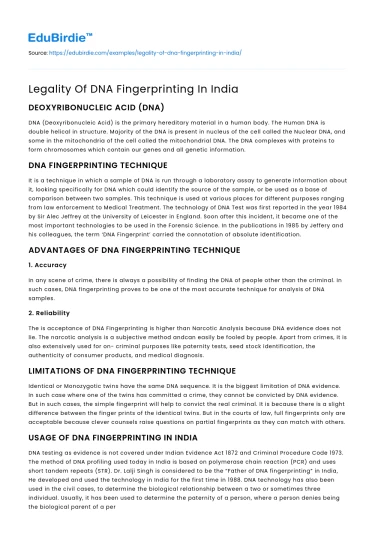DEOXYRIBONUCLEIC ACID (DNA)
DNA (Deoxyribonucleic Acid) is the primary hereditary material in a human body. The Human DNA is double helical in structure. Majority of the DNA is present in nucleus of the cell called the Nuclear DNA, and some in the mitochondria of the cell called the mitochondrial DNA. The DNA complexes with proteins to form chromosomes which contain our genes and all genetic information.
DNA FINGERPRINTING TECHNIQUE
It is a technique in which a sample of DNA is run through a laboratory assay to generate information about it, looking specifically for DNA which could identify the source of the sample, or be used as a base of comparison between two samples. This technique is used at various places for different purposes ranging from law enforcement to Medical Treatment. The technology of DNA Test was first reported in the year 1984 by Sir Alec Jeffrey at the University of Leicester in England. Soon after this incident, it became one of the most important technologies to be used in the Forensic Science. In the publications in 1985 by Jeffery and his colleagues, the term ‘DNA Fingerprint’ carried the connotation of absolute identification.
Save your time!
We can take care of your essay
- Proper editing and formatting
- Free revision, title page, and bibliography
- Flexible prices and money-back guarantee
ADVANTAGES OF DNA FINGERPRINTING TECHNIQUE
1. Accuracy
In any scene of crime, there is always a possibility of finding the DNA of people other than the criminal. In such cases, DNA fingerprinting proves to be one of the most accurate technique for analysis of DNA samples.
2. Reliability
The is acceptance of DNA Fingerprinting is higher than Narcotic Analysis because DNA evidence does not lie. The narcotic analysis is a subjective method andcan easily be fooled by people. Apart from crimes, it is also extensively used for on- criminal purposes like paternity tests, seed stock identification, the authenticity of consumer products, and medical diagnosis.
LIMITATIONS OF DNA FINGERPRINTING TECHNIQUE
Identical or Monozygotic twins have the same DNA sequence. It is the biggest limitation of DNA evidence. In such case where one of the twins has committed a crime, they cannot be convicted by DNA evidence. But in such cases, the simple fingerprint will help to convict the real criminal. It is because there is a slight difference between the finger prints of the identical twins. But in the courts of law, full fingerprints only are acceptable because clever counsels raise questions on partial fingerprints as they can match with others.
USAGE OF DNA FINGERPRINTING IN INDIA
DNA testing as evidence is not covered under Indian Evidence Act 1872 and Criminal Procedure Code 1973. The method of DNA profiling used today in India is based on polymerase chain reaction (PCR) and uses short tandem repeats (STR). Dr. Lalji Singh is considered to be the “Father of DNA fingerprinting” in India, He developed and used the technology in India for the first time in 1988. DNA technology has also been used in the civil cases, to determine the biological relationship between a two or sometimes three individual. Usually, it has been used to determine the paternity of a person, where a person denies being the biological parent of a person. DNA parentage testing may help a person in absolving him from the charge of being the biological parent of a person, but it cannot be trusted to prove absolutely that a person is the child’s biological parent; however it can provide a probability.
ADMISSIBILITY OF DNA EVIDENCE IN INDIAN COURT
The admissibility of the DNA evidence before the court always depends on its accurate and proper collection, preservation and documentation which can satisfy the court that the evidence which has been put in front it is reliable. There is no specific legislation which is present in Indian which can provide specific guidelines to the investigating agencies and the court, and the procedure to be adopted in the cases involving DNA as its evidence. Moreover, there is no such specific provision under Indian Evidence Act, 1872 and Code of Criminal Procedure 1973 to manage science and technology issues. Due to lack of having any such provision, an investigation officer has to face much trouble in collecting evidences which involves modern mechanism to prove the accused person guilty.
Section 53 of Code of Criminal Procedure 1973 authorizes a police officer to get the assistance of a medical practitioner in good faith for the purpose of the investigation. But, it doesn’t enable a complainant to collect blood, semen etc for bringing the criminal charges against the accused. The amendment of CrPC by the CrPC (Amendment) Act, 2005 has brought two new sections which authorizes the investigating officer to collect DNA sample from the body of the accused and the victim with the help of medical practitioner. These sections allow examination of person accused of rape by medical practitioner and the medical examination of the rape victim respectively. But the admissibility of these evidences has remained in a state of doubt as the opinion of the Supreme Court and various High Courts in various decisions remained conflicting. Judges do not deny the scientific accuracy and conclusiveness of DNA testing, but in some cases they do not admit these evidences on the ground of legal or Constitutional Prohibition and sometimes for the public policy. There is an urgent need to re-examine these sections and laws as there is no rule present in the Indian Evidence Act, 1872 and Code of Criminal Procedure, 1973 to manage science and technology issues.






 Stuck on your essay?
Stuck on your essay?

